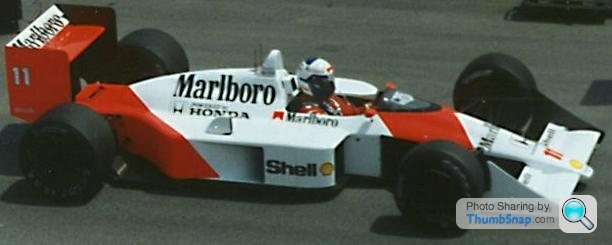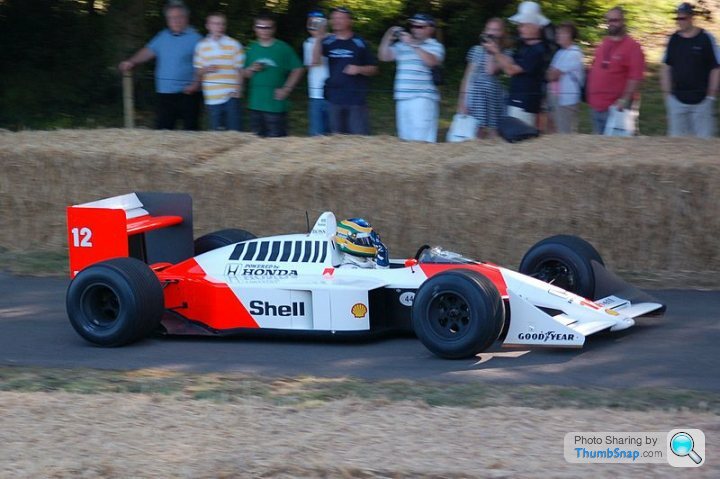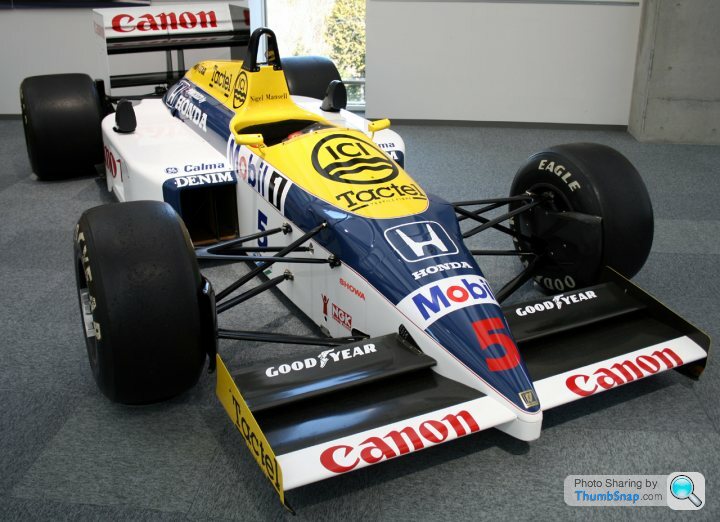1970s F1 - airboxes
Discussion
Good point.
Most turbo cars didn't even have the snorkels though and those teams that did try them did not retain them for long. So my point is that feeding the air through any sort of oversized intake into the system conferred little advantage - certainly with the turbos of that era.
Things may be different now, of course, as the turbos are far more sophisticated and airflow is far better understood.
Most turbo cars didn't even have the snorkels though and those teams that did try them did not retain them for long. So my point is that feeding the air through any sort of oversized intake into the system conferred little advantage - certainly with the turbos of that era.
Things may be different now, of course, as the turbos are far more sophisticated and airflow is far better understood.
Eric Mc said:
I suppose you could look on them as a form of airbox. I was thinking of the more "traditional" type i.e. above or on either side of the roll over bar.
And the fact that the snorkel type seemed to be in use by a small number of teams for a short period of time indicates that they didn't confer much of an advantage.
I think they were on most of the turbo cars from the mid '80's.And the fact that the snorkel type seemed to be in use by a small number of teams for a short period of time indicates that they didn't confer much of an advantage.
If you look at the combined inlet areas of a typical twin periscope system of that era, it doesn't look much smaller than the equivalent normally aspirated car airbox.
I think the omission of airboxes on early 80's normally aspirated cars might be to do with aerodynamics combined with progressively more restrictive regulations.
I'm almost surprised that the retention of high airboxes on 2014 cars isn't mandatory for sponsorship reasons. It wouldn't be the first time rules have been made specifically for the benefit of sponsorship.
HarryFlatters said:
Where were the intercoolers on an 80s turbo car? I'm presuming in the sidepods?
If so, that's where the air intake would be, so no need for a big draggy hole above the driver's head.
The intercooler is placed after the compressor, so it's pretty mcuh irrelevant in terms of inlet placement.If so, that's where the air intake would be, so no need for a big draggy hole above the driver's head.
dr_gn said:
The intercooler is placed after the compressor, so it's pretty mcuh irrelevant in terms of inlet placement.
Fair point 
Looking at images of the 80s engines, the turbos are shown low down, presumably for lower CofG..
http://www.pistonheads.com/gassing/post.asp?h=0&am...
So I'd guess that the intakes are low down, so you don't need to funnel air to them.
Anyways, I'm guessing

HarryFlatters said:
dr_gn said:
The intercooler is placed after the compressor, so it's pretty mcuh irrelevant in terms of inlet placement.
Fair point 
Looking at images of the 80s engines, the turbos are shown low down, presumably for lower CofG..
http://www.pistonheads.com/gassing/post.asp?h=0&am...
So I'd guess that the intakes are low down, so you don't need to funnel air to them.
Anyways, I'm guessing

Eric Mc said:
There had been an earlier ruling about the maximum height of an F1 car being the roll over bar. The tall airboxes contravened that rule. Therefore, in 1976, it was made mandatory that the airbox could not be taller than the roll over structure. Consequently, the airboxes were either reduced in size, split in two and placed either side op the rollover bar or abandoned altogether.
I'm reading the Hunt/Lauda bookazine. It features the 1976 Italian GP report and reports on the debacle in scrutineering when no two cars were ever the same despite same team and same airboxes!Eric Mc said:
In the late 70s they had begun to disappear off the NA cars. Alan Jones's DFV powered 1980 Williams didn't have an airbox, for example.
The 1980s turbos didn't need them, it seems.
When the 3.5 litre NA cars came out in 1987, they WERE fitted with airboxes and they have remained a feature on NA F1 cars ever since.
How would they work in conjunction with forced induction - that's what I was wondering.
Not all, and this was much better for it...The 1980s turbos didn't need them, it seems.
When the 3.5 litre NA cars came out in 1987, they WERE fitted with airboxes and they have remained a feature on NA F1 cars ever since.
How would they work in conjunction with forced induction - that's what I was wondering.
[pic]http://formula1.ferrari.com/wp-content/themes/formula1/history/images/89_pic1_big.jpg[pic]
Piginapoke said:
Eric Mc said:
In the late 70s they had begun to disappear off the NA cars. Alan Jones's DFV powered 1980 Williams didn't have an airbox, for example.
The 1980s turbos didn't need them, it seems.
When the 3.5 litre NA cars came out in 1987, they WERE fitted with airboxes and they have remained a feature on NA F1 cars ever since.
How would they work in conjunction with forced induction - that's what I was wondering.
Not all, and this was much better for it...The 1980s turbos didn't need them, it seems.
When the 3.5 litre NA cars came out in 1987, they WERE fitted with airboxes and they have remained a feature on NA F1 cars ever since.
How would they work in conjunction with forced induction - that's what I was wondering.
[pic]http://formula1.ferrari.com/wp-content/themes/formula1/history/images/89_pic1_big.jpg[pic]
I wasn't categorically stating that ALL normally aspirated 1987 to 90 cars had airboxes. But when they DID appear in 1987 I was surprised to see them because they had disappeared from the normally aspirated cars from around 1979 to 1984.
I remember thinking at the "Why they were making a comeback now?".
I remember thinking at the "Why they were making a comeback now?".
Eric Mc said:
I wasn't categorically stating that ALL normally aspirated 1987 to 90 cars had airboxes. But when they DID appear in 1987 I was surprised to see them because they had disappeared from the normally aspirated cars from around 1979 to 1984.
I remember thinking at the "Why they were making a comeback now?".
But they hadn't disappeared on n/a cars by '84. OK some didn't have them...but others did.I remember thinking at the "Why they were making a comeback now?".
Eric Mc said:
It was variable as to who had them and who hadn't. They had once been universal.
I can think of at least two teams who had cars running with and without them depending on the circuit. The '82 Williams FW08 for example ran with and without an airbox at various times, so it's not as clear cut as one team had them and another team didn't. I would expect the decision was about the drag vs power trade-off w.r.t. various types of circuit. Also, the n/a engines of the early '80's era weren't producing as much power as those of the '89 onwards era, so assuming top speeds were abuot the same,I assume any percentage gain in power would be proportionately higher with the more powerful engines, thereby making the drag vs power trade off more clear cut...in favour of power.
Just by the by, didn't those 80s cars look fantastic.....
MP4/4:
with airboxes:

without:

FW11 11/B with:

without:

dr_gn said:
PhillipM said:
Bodywork regs or similar perhaps didn't make it worth the effort? Not really looked into it in detail, it might just be that the dynamics of the airboxes weren't fully understood and they thought it wouldn't help with a turbo in the way - look how many people used to, and still do, run air intakes that converge instead of diverge.
I remember that both the Williams FW11 (86/87) and McLaren MP4/4 ('88) both had, at some point snorkel type turbo inlets above each sidepod, which substituted inlets flush with (or inside) the sidepods. I think the Williams definitely finished its development with the snorkels, but can't remember if or how development was settled on the McLaren.Edited by PhillipM on Thursday 10th October 15:34
MP4/4:
with airboxes:

without:

FW11 11/B with:

without:

Edited by dr_gn on Thursday 10th October 15:54
Gassing Station | Formula 1 | Top of Page | What's New | My Stuff



